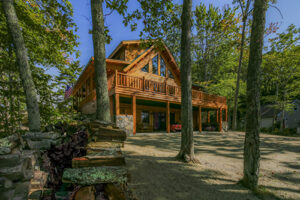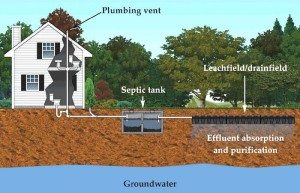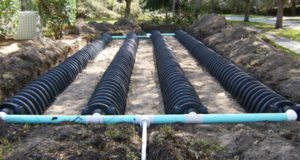 Chances are that your new Katahdin Cedar Log Home will require a septic system be installed to handle your home’s waste, since many log homes are built in rural settings. If you’ve never lived in a home with a septic system, the prospect can be a little daunting, so we’ve created this Septic System Primer to get you up to speed. We hope that this information will help to answer your questions!
Chances are that your new Katahdin Cedar Log Home will require a septic system be installed to handle your home’s waste, since many log homes are built in rural settings. If you’ve never lived in a home with a septic system, the prospect can be a little daunting, so we’ve created this Septic System Primer to get you up to speed. We hope that this information will help to answer your questions!
Soils Testing is the First Step
When you purchased your land, one of the conditions that likely was required was a satisfactory soils or percolation test be conducted where the septic system would likely be located on the land. This soils test will determine whether the soils are of sufficient depth, consistency and moisture level to support a well-functioning drain field. For a deep dive into soil types, this article has expanded information. In a nutshell, if the soil has too much clay, has ledge formations or is located too close to a body of water, a conventional septic system may not be possible. Read on below for other options for septic systems.
 What are the components of a conventional septic system?
What are the components of a conventional septic system?
Septic systems are designed to collect solid and liquid waste from you home and process it so that the surrounding land and groundwater are not affected. Typically, a conventional septic system has these components:
- Septic Tank —collects the effluent from the house for dispersal over a drainfield
- Drain Field —consists of long trenches filled with gravel and sand then covered with a nonpermeable fabric to keep the stones clean. The liquid flows through the trenches where it is filtered and treated by naturally occurring bacteria. Drain fields require a large area which may not be suitable for certain lot configurations.
- Septic Pump— this ensures the effluent from the home reaches the septic tank and drain field for efficient disposal. This component is particularly important if the tank and drain field are located any distance from the home or uphill from the waste outlet plumbing. The septic pump must be connected to power to function.
Other Types of Septic Systems
If the soils or logistics of your land are not supportive of a conventional septic system, there are alternatives.
- Mound system — This form of septic disposal overcomes the unacceptable soils by trucking in gravel and sand to construct a mound that will process the liquid effluent. Mound systems have an extra chamber called a dosing chamber that collects the liquid and then when a sufficient amount is collected, it is dosed, or distributed, over the leach field of sand and gravel in the mound. The dosing chamber requires venting and may require some monitoring to ensure proper function.
- Chamber System— Often called a gravelless system, this septic option uses several elongated plastic chambers in place of sand and gravel drain fields to
 collect and treat the effluent when it comes into contact with the soil. These are used in locations where a mound system is impractical, or gravel costs are high.
collect and treat the effluent when it comes into contact with the soil. These are used in locations where a mound system is impractical, or gravel costs are high.
What Size Septic System?
In most municipalities septic systems designs are sized based on the number of bedrooms as a reasonable prediction of number of occupants and amount of waste. Some things that can affect (increase) the size of a septic design are accessory dwellings and garbage disposals. Because of the increased cost, many rural homeowners opt not to have garbage disposals installed in their kitchens.
These are just a few of the options for septic systems in rural areas. It’s important to consult with a septic design specialist well in advance of construction to ensure your septic system is capable of servicing your new Katahdin Cedar Log Home.
